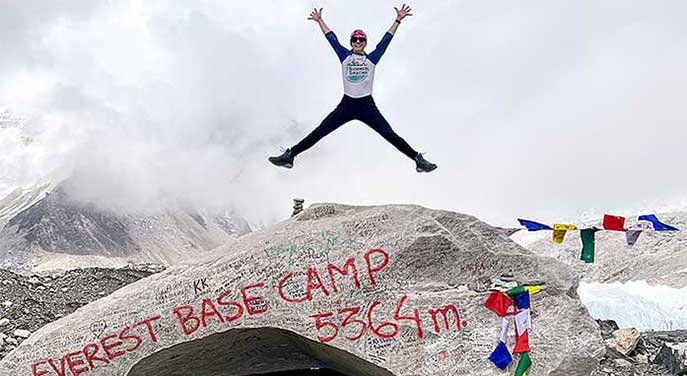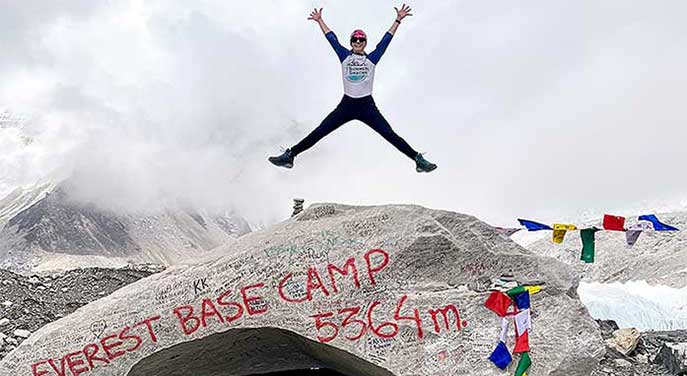When you hear stories about Everest, they usually involve people trying to get up the mountain.

Kate Story
Not for Kate Storey. At the end of May, she ran the Everest Marathon – a 42.2-km race down the mountain from Everest’s South Base Camp that took her seven and a half hours. She finished as the second-quickest international female and eighth-quickest female overall.
When she’s not running the world’s highest marathon, Storey works as an associate professor in the School of Public Health at the University of Alberta. She’s also a Stollery Science Lab Distinguished Researcher, a CIHR/PHAC Applied Public Health Chair and director of SIRCLE, a research group that encourages schools to promote wellness with students through physical activity, healthy eating and positive mental health.
Whether working with kids or pushing herself to the limit, Storey has found that it takes a village to reach your goals. Here’s what she has learned about the importance of community when setting out to achieve your objectives.
Embrace support
While running may not seem like a team sport, Storey had a whole crew – including friends, training mates, physiotherapists, doctors and trainers – helping her prepare for the race. And the team spirit continued on the mountain. Local runners gave her tips, guides encouraged her during training, and participants checked in on one another. “It’s okay to lean on others for help,” Storey says. “There’s no way I could have done this race alone.”
Likewise, in her youth programs, support networks play a big role. The Indigenous Youth Mentorship Program, co-led by SIRCLE, is an after-school mentorship program based on the teachings of Indigenous scholars, in which younger kids learn from and are supported by Indigenous high school students. The mentors promote kids’ well-being through physical activity, nutrition and relationship building while instilling values including Belonging, Mastery, Independence and Generosity (from the Circle of Courage model).
Build resilience
|
Related Stories |

|
| Angkor Wat: remote, mysterious and architecturally inspiring
|
| In search of Borneo’s elusive ‘man of the forest’
|
| Immersed in the zesty flavours of Kerala, India
|
| More in Travel |
Running down Mount Everest is no easy feat. Storey had to be disciplined about her health and training regimen, which included strength training, Pilates, stairs and lots of running. She also trained in an altitude chamber to help prepare her body for differences in oxygen levels on the mountain. “There’s times when you don’t want to,” she says. “It’s 4:30 a.m. and you’re waking up to train and thinking, ‘What am I doing?’”
When facing the marathon’s tough aspects, she thought about the kids she works with and their ability to overcome hardship. “Many youth over the pandemic have faced big challenges,” Storey says. If they can do that, she thought while she was on the mountain, I can do this.
Connect with yourself and the world
No matter what part of the journey she was on, Storey focused on enjoying the marathon, which included tuning into the natural world around her. “That applies to work I do with youth – getting kids outside and connected to nature,” she says.
One of her research projects, Active School Travel, encourages kids to get to and from school by walking, biking or wheeling. Doing something active that you enjoy while outdoors is good for the soul, she says, as well as the body and mind.
Come together for good
Before heading to Nepal for the race, Storey participated in the Million Reasons Run, where people set goals and run on their own schedules to raise funds for their local children’s hospital. Along with some of her team at SIRCLE, she ran throughout the month of May to raise money for Edmonton’s Stollery Children’s Hospital. She finished the month with the marathon.
It was a way to team up for a greater cause, Storey says, and she embraced every minute of it. “You see people along the way, but a lot of the time you’re just by yourself running in the Himalayas,” she says. “It’s pretty incredible to do that.”
Enjoy the journey
Crossing the finish line was an achievement, but Storey is more excited about the journey it took to get there. “I knew that the entire experience would be wonderful, from being in Kathmandu to meeting people in the communities along the way,” she says.
“By the time we got to base camp, I knew I felt good,” she says. “Then I thought, ‘I’m going to be able to race, and this is going to be fabulous.’”
It took her 10 days to hike to the marathon’s starting point – an elevation gain of 5,364 metres. After the marathon, Storey still had to trek another 25 km down to the town of Lukla, Nepal. But she enjoyed the challenge, exemplifying what she promotes in her after-school programs: having fun is a major part of building a healthy lifestyle.
| By Raylene Lung
Raylene is a reporter with the University of Alberta’s Folio online magazine. The University of Alberta is a Troy Media Editorial Content Provider Partner.
The opinions expressed by our columnists and contributors are theirs alone and do not inherently or expressly reflect the views of our publication.
© Troy Media
Troy Media is an editorial content provider to media outlets and its own hosted community news outlets across Canada.

